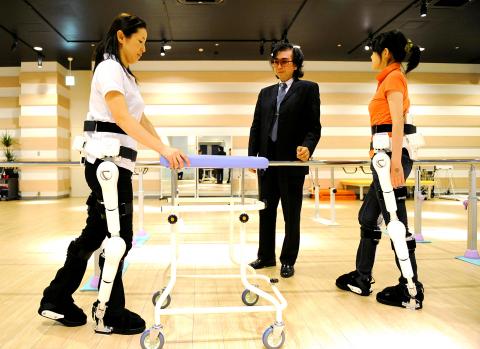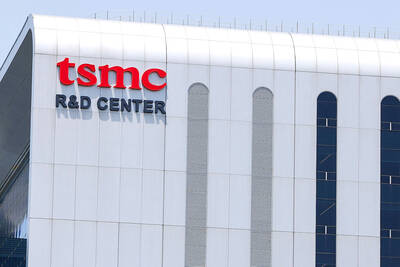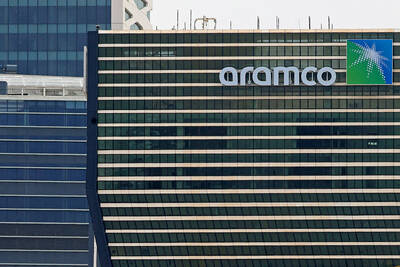Japan’s Cyberdyne may share its name with the company responsible for nuclear destruction and the killer robots of the Terminator movie series, but the similarities end there.
And if the idea of a robot suit helping those with disabilities walk sounds like the stuff of science fiction, think again: The real-life Cyberdyne is in the business of revolutionizing lives.
The firm produces an exoskeleton robot device called the Hybrid Assistive Limb, or HAL, which in another sci-fi related coincidence shares its name with the devious computer in Stanley Kubrick’s 2001: A Space Odyssey.

PHOTO: AFP
It gives power to its wearer by anticipating and supporting the user’s body movements using sensors monitoring electric signals sent from the brain to the muscles.
Current options are for a single leg device or both legs.
HAL has many potential applications, from assisting caregivers lift people to helping construction workers or even firefighters.
In one case, three weeks of training with HAL enabled a man who had suffered brain injuries to stand on his own feet after nine years in a wheelchair, said Cyberdyne CEO Yoshiyuki Sankai, a professor at the University of Tsukuba.
The group is now gearing up for mass-production and started leasing the -battery-powered suit to welfare facilities last year.
“Developing robots without utilizing them in society would just be an extension of a hobby,” Sankai, 52, said. “What I develop should be part of society and benefit people.”
A Japanese adventurer with disabilities is planning to leave his wheelchair behind and walk up a medieval French World Heritage site next year with the lower-limb HAL.
Seiji Uchida, 48, who lost the ability to walk in a car accident 27 years ago, said earlier this year he has long dreamed of visiting the picturesque abbey of Mont Saint-Michel, set on a rocky islet in the region of Normandy.
Uchida said his visit to the island where a steep and narrow trail leads to an abbey and former fortress was to “prove that it is possible for people with disabilities to visit the world’s historic sites without relying on facilities like elevators.”
About 50 hospitals and homes for the elderly in Japan are using a lower-limb version of HAL to assist disabled people. Rental fees for both legs are ¥140,000 to ¥150,000 a month (US$1,600 to US$1,800).
Cyberdyne plans to start leasing a full-body version for caregivers next year, which assists both arms and legs and allows users to carry a load of up to 70kg with one arm.
It aims to begin sales to consumers from 2015.
More than 60 people have signed up as regular visitors to Cyberdyne Studio, a walking--training version of the usual fitness clubs that opened in September in Tsukuba City northeast of Tokyo, using the lower-limb model.
Sankai’s approach of putting practicality first is unique in a country where many researchers focus on high concept robotics with eye-catching, headline--grabbing humanoids and other machines that have little useful application in reality. The professor is critical of research that has no use outside the laboratory.
“Many in the research and development field are motivated by their own interest. They produce a thing and then think, ‘What could this be used for?’ Research isn’t for just writing papers,” he said.
Sankai has retained his enthusiasm since his days as a self-styled child scientist who practiced melting aluminum in the backyard and built walkie-talkies from scratch.
He said he had wanted to develop robots since he was a child and remembers “odd experiments” he did, such as giving a frog’s leg an electric stimulus by using a home-made radio-wave transmitter.
Sankai is now in talks with foreign companies such as France’s Bouygue construction group.
“We are exploring cooperation outside the medical and welfare field, for ways to help heavy physical work,” he said.
Bayer MaterialScience in the German conglomerate Bayer -announced in October it would help Cyberdyne replace metal parts with high-quality plastics to pave the way for easier and cheaper production of the complex shaped suit.
HAL will also be tried out in hospitals in Denmark and Sweden.
Sankai plans to invite foreign students on training programs at Tsukuba, educate them on using HAL and send them home with joint research contracts.
HAL could also be used by rescue workers, Sankai said.
“People from the fire and disaster management agency came to me and told me about rescuers who lost their lives while on duty,” he said, making him think an appropriate machine could save lives.
“I want to think about what our technology can contribute,” Sankai said.

BIG BUCKS: Chairman Wei is expected to receive NT$34.12 million on a proposed NT$5 cash dividend plan, while the National Development Fund would get NT$8.27 billion Taiwan Semiconductor Manufacturing Co (TSMC, 台積電), the world’s largest contract chipmaker, yesterday announced that its board of directors approved US$15.25 billion in capital appropriations for long-term expansion to meet growing demand. The funds are to be used for installing advanced technology and packaging capacity, expanding mature and specialty technology, and constructing fabs with facility systems, TSMC said in a statement. The board also approved a proposal to distribute a NT$5 cash dividend per share, based on first-quarter earnings per share of NT$13.94, it said. That surpasses the NT$4.50 dividend for the fourth quarter of last year. TSMC has said that while it is eager

‘IMMENSE SWAY’: The top 50 companies, based on market cap, shape everything from technology to consumer trends, advisory firm Visual Capitalist said Taiwan Semiconductor Manufacturing Co (TSMC, 台積電) was ranked the 10th-most valuable company globally this year, market information advisory firm Visual Capitalist said. TSMC sat on a market cap of about US$915 billion as of Monday last week, making it the 10th-most valuable company in the world and No. 1 in Asia, the publisher said in its “50 Most Valuable Companies in the World” list. Visual Capitalist described TSMC as the world’s largest dedicated semiconductor foundry operator that rolls out chips for major tech names such as US consumer electronics brand Apple Inc, and artificial intelligence (AI) chip designers Nvidia Corp and Advanced

Saudi Arabian Oil Co (Aramco), the Saudi state-owned oil giant, yesterday posted first-quarter profits of US$26 billion, down 4.6 percent from the prior year as falling global oil prices undermine the kingdom’s multitrillion-dollar development plans. Aramco had revenues of US$108.1 billion over the quarter, the company reported in a filing on Riyadh’s Tadawul stock exchange. The company saw US$107.2 billion in revenues and profits of US$27.2 billion for the same period last year. Saudi Arabia has promised to invest US$600 billion in the US over the course of US President Donald Trump’s second term. Trump, who is set to touch

SKEPTICAL: An economist said it is possible US and Chinese officials would walk away from the meeting saying talks were productive, without reducing tariffs at all US President Donald Trump hailed a “total reset” in US-China trade relations, ahead of a second day of talks yesterday between top officials from Washington and Beijing aimed at de-escalating trade tensions sparked by his aggressive tariff rollout. In a Truth Social post early yesterday, Trump praised the “very good” discussions and deemed them “a total reset negotiated in a friendly, but constructive, manner.” The second day of closed-door meetings between US Secretary of the Treasury Scott Bessent, US Trade Representative Jamieson Greer and Chinese Vice Premier He Lifeng (何立峰) were due to restart yesterday morning, said a person familiar